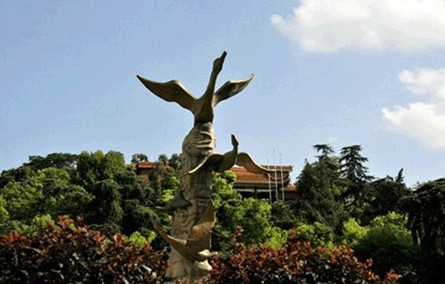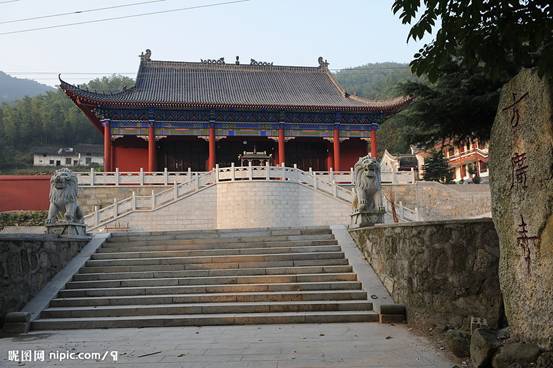| Cultural Relics in Hengyang |
| From:湖南省政府网 | Date Add in:2019-07-24 11:08:00 [A A] |
|
1.
Huiyan Peak is the first of 72 Nanyue peaks. This famous Tang Dynasty poet Dufu wrote about the peak, saying that each year the swallow from the north will never go further south, and wouldn’t return home until the next spring. Entering the gate of the mountain, visitors will first see the half-hill pavilion. Further along, after turning across “the hundreds` ladders,” visitors will reach the mountain where the Yanfeng Temple is located. The temple is one of the four great temples of Zen Buddhism where a lot of eminent monks visit.
2. Zhu Hui Pagoda
Zhu Hui Pagoda lies in the south of the Baiting Mountain of Cha Shan’ao County, Hengyang. The Zhu Hui Pagoda and the Wild Goose Arrival Pagoda face each other on the opposite side of the Xiang River. The pagoda is 38.15 meters high with a base 7.5 meters in width. Facing the south, it set on a base engraved with dragons, phoenixes, clouds, mountains, waters, flowers, and other auspicious birds and animals.ang Zhichu suggested building the Zhu Hui Pagoda, and it was completed two years later in 1897.
The pagoda is a typical brick cone shape, and is composed seven stories and eight layered piles. Each story has tiers of upturned eaves shaped like fish tails. An iron gourd is installed on its top. Each floor has four rooms and two windows. There are stone banners and couplets on the first three floors, particularly on the first floor. The north-south doors are used to enter and the east-west doors are used to ascend. Above the door is a white marble carving with the three Chinese characters “Zhu Hui Ta”. There are couplets on each side of the door. There once was a marble monument which documented the building the pagoda. Wang Xianqian wrote the article and Huang Ziyuan inscribed the calligraphy. The work itself is a treasure; unfortunately, it was stolen in 2002.
3.Shigu Park
Shigu Park locates at the joint between Zheng Tributary and Xiang River. It lies
on Shigu Mountain, which is outside the north gate of the Hengyang city. It covers an area of 4,000 square meters with huge 2 meter high drum-shaped stone blocks.
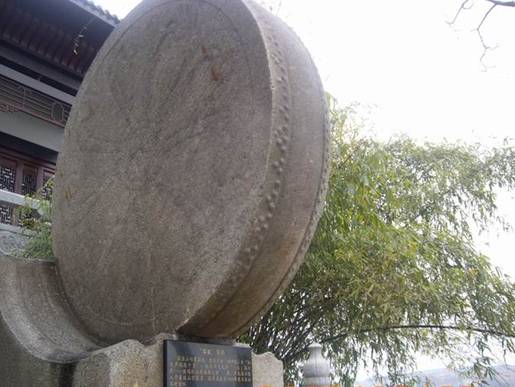
Shigu Mountain was called the first paradise in Hunan province because of its flourishing landscape. In ancient times this attracted numerous well educated men to visit and give a speech. During the Anti-Japanese War, the building was damaged, but was later restored into a park.
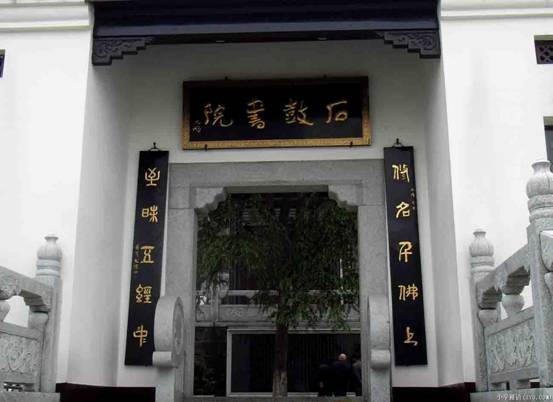
4. Donhan Tomb
Donhan Tomb, in Yuxin Forest along the bank of the Zheng Tributary, is the largest tomb from the Donhan historical period. The tomb is made up of three rooms, each 3 meters high, 15.5 meters long, and 7.2 meters wide. There were many objects unearthed from the tomb, such as a bronze horse and a bronze mirror. Among the more unusual discoveries were a lead-horse toxng and a bronze horse. The Donhan bronze horse has been given the title of a First Class Cultural Relic by the State Cultural Relics Bureau.
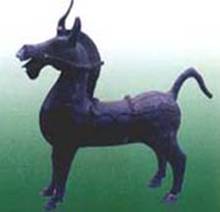
5. Nanyue Mountain
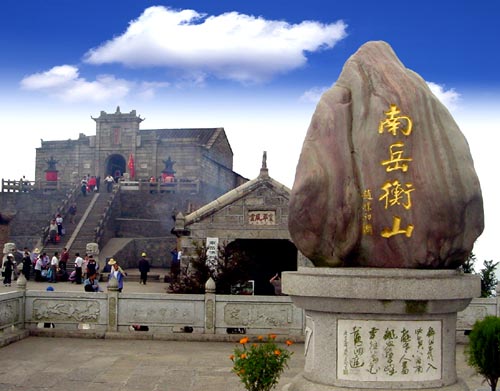
Hengshan, named the Southern Mountain of the Five Sacred Mountains, is located in Hengyang County. It has 72 peaks, and extends 150 kilometers, with over 1200 kilometers in circumference. Huiyan Peak is the southernmost peak, while Yuelu Mountain in Changsha city is the northernmost. Zhurong Peak is the highest at 1,290 meters above sea level. On the top of this peak, a Shaolin Temple and a sunrise viewing platform are the best scenic spots. Besides marvelous temples, the mountain also boasts 9 ponds, 9 wells, 9 pools, 10 caves, 15 rocks formations, 25 streams and 38 springs.
As early as 2,000 years ago, many emperors and scholars, including famous poets Li Bai, Du Fu and Zhu Xi, visited Hengshan and inscribed their poems in the mountain. With its beautiful scenery and rich cultural heritage, the mountain attracts travelers both home and abroad.
The biggest temple in the mountain is the Nanyue Temple, which is the largest group of ancient buildings in Hunan Province, covering an area of 100,000 square meters.
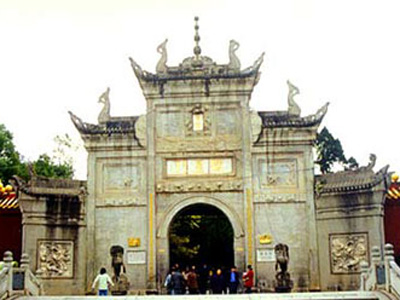
Among the temples in the mountain, the Fuyan Temple is known as the nation’s "First Temple of Buddhist Doctrine", with a maidenhair tree of 1,400 years old; the Nantai Temple has a history of over 1,400 years and is regarded as the origin of a Buddhist branch in Japan; the Tripitaka Temple, famous for its delicacy and enfeoffed Confucian classics, is surrounded by such oddly-shaped ancient trees like Money Tree, Tree of Love, etc., and many historic sites like Shushing Tai and Diary Tai and Yinchuan Pavilion. The Fangguang Temple, which is quiet with a forest of ancient trees, and the Water-Screen Cave, which is mysterious, are all spots of interest.
The renowned Four Wonders of the Southern Mountain are, namely, the loftiness of Zhurong Peak, the delicacy of Tripitaka Temple, the quietness of Fangguang Temple and the mystery of Water-screen Cave.
5.1 Nanyue Temple is the largest group of ancient buildings in Hunan Province, covering an area of 100,000 square meters. The temple came into existence as early as the Sui Dynasty (581-618 A. D.), demonstrating the wisdom and intelligence of the people of ancient times. It is composed of many monasteries in and outside the main hall, which are splendorous, magnificent, delicate and precise in layout. Eight Taoist monasteries and the eight Buddhism temples stand on both sides of the Great Temple. It is shared by believers of local gods, Buddhism, and Taoism. The temple, which is glazed in red and yellow, is linked with many other buildings, creating a grand palace complex. Lingxing Gate, the main opening of Nanyue Temple, is 20-meter-high. The main hall, known as Shendi Hall, is 22 meters high, supported by 72 stone pillars, which symbolize the 72 peaks of the mountain. The center of the hall contains a figure to represent the Nanyue God Emperor. Past the main hall is a mausoleum which contains sitting figures of a Patron Father and Patron Mother. On the sides there are two halls, Zhusheng Hall, which is Taoist, and Xiashen Hall, a Buddhist hall.
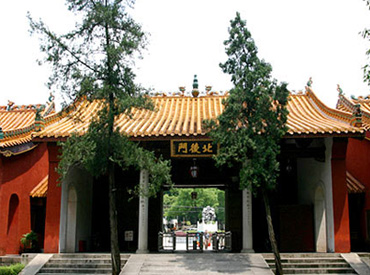
5.2 The delicacy of Tripitaka Temple
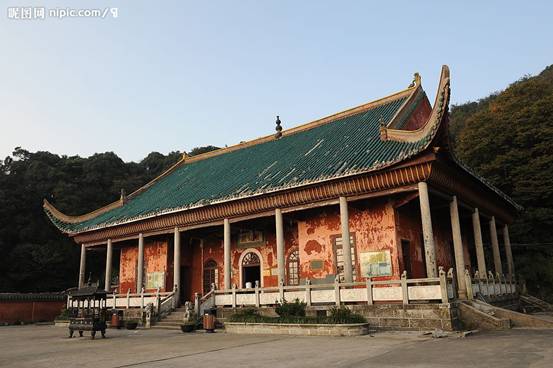
Tripitaka Temple is a well-known Buddhist temple built in the ancient style of the South Chen Dynasty (568 BC). The temple is approximately 400 square meters in size, and its roof, which is covered in glazed tiles, shines brightly in the sunlight. It is surrounded by oddly-shaped ancient trees, such as the Money Tree and the Tree of Love. It also contains many historic sites like Shuzhuang Pavilion and Yunchun Pavilion.
5.3 The Quietness of Fangguang Temple
Fangguang Temple is located at the foot of the Lotus Peak of Nanyue Mountain. It was first built to preach Buddhism by a Huihai, a Zen master during the Liang Dynasty in 503 BC. In front of the temple, there is a stream where it is said that Huihai once cleaned his clothes. To the left of the temple, there is a deep pool with a stone over 30 meters high in the middle of the pool. A spring flows out of the stone, forming a wide waterfall over 10 meters high. The temple is surrounded by numerous ancient and precious trees, thus creating the quiet atmosphere.
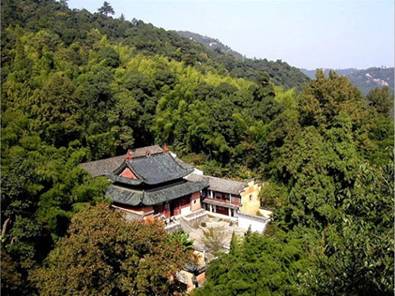
|
Co-sponsored by Information Office of Hengyang Municipal People's Government Technical Support & Design:Hengyang Normal University
ICP NO:05002289
